An Analysis of Toyota's Supply Chain Management and Recommendations
VerifiedAdded on 2020/07/22
|10
|2875
|44
Report
AI Summary
This report provides a critical review of Toyota's supply chain management, examining its strategies, challenges, and performance. The introduction highlights Toyota's global presence, manufacturing processes, and its adoption of lean manufacturing. Task 1 delves into the supply chain management system, discussing customer satisfaction, information flow, and supplier performance as key indicators. The analysis section explores various strategies, including lean and agile methodologies, logistic strategies, and procurement approaches, and their impact on Toyota's operations. The report also touches upon the Just-in-Time (JIT) method. The conclusion summarizes the findings and offers recommendations to optimize Toyota's supply chain, improve efficiency, and maintain its competitive advantage in the automotive industry. The report emphasizes the importance of continuous improvement and strategic adaptation to address challenges and enhance performance.
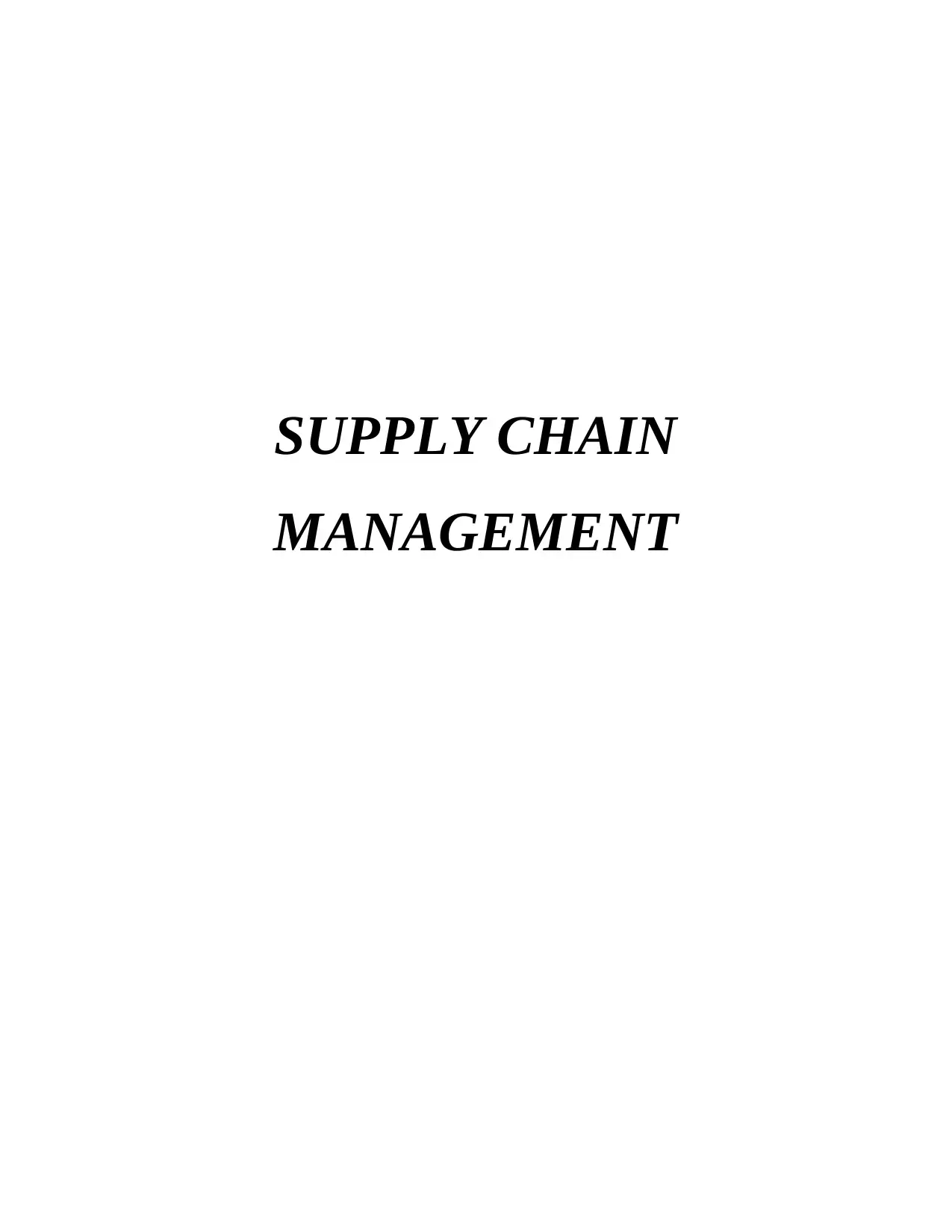
SUPPLY CHAIN
MANAGEMENT
MANAGEMENT
Paraphrase This Document
Need a fresh take? Get an instant paraphrase of this document with our AI Paraphraser
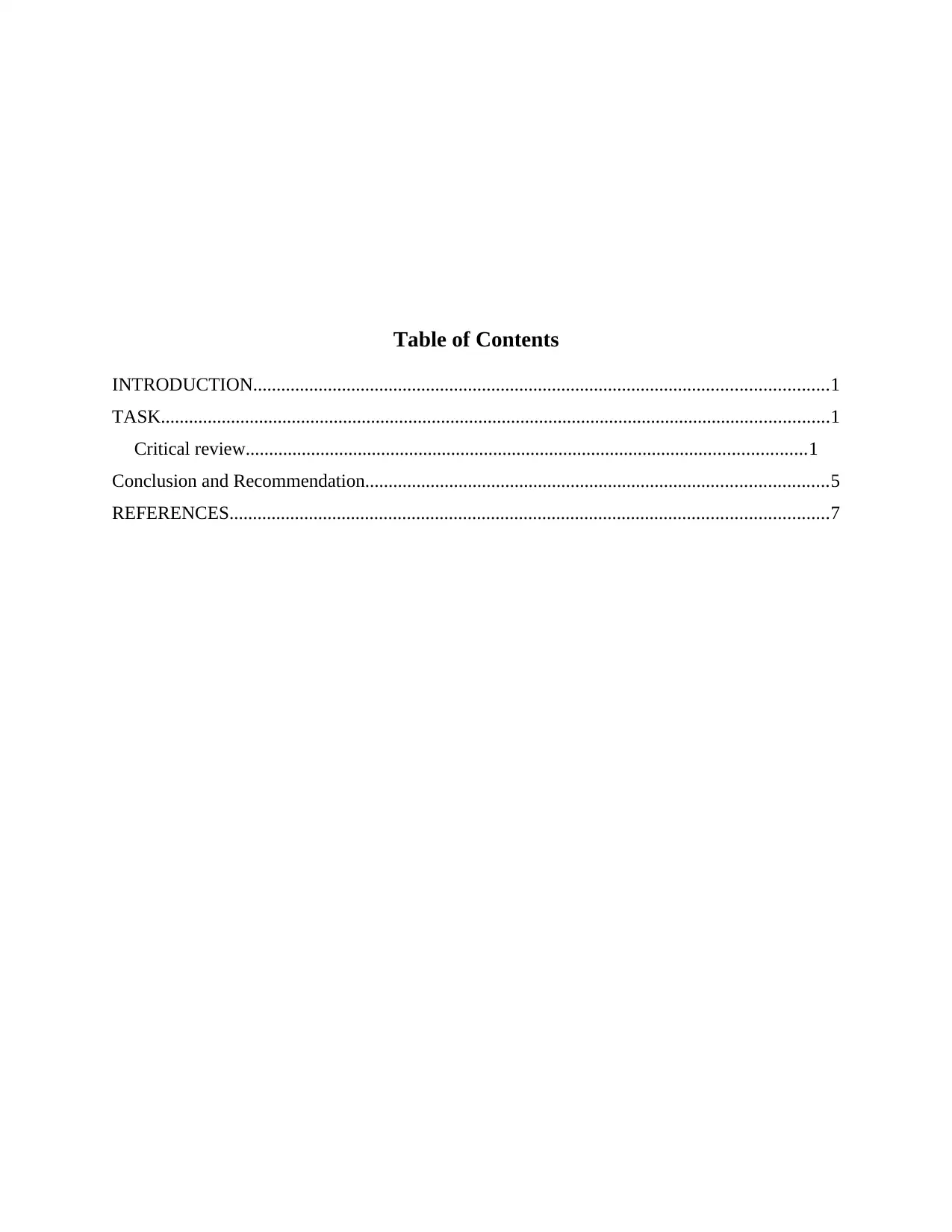
Table of Contents
INTRODUCTION...........................................................................................................................1
TASK...............................................................................................................................................1
Critical review........................................................................................................................1
Conclusion and Recommendation...................................................................................................5
REFERENCES................................................................................................................................7
INTRODUCTION...........................................................................................................................1
TASK...............................................................................................................................................1
Critical review........................................................................................................................1
Conclusion and Recommendation...................................................................................................5
REFERENCES................................................................................................................................7
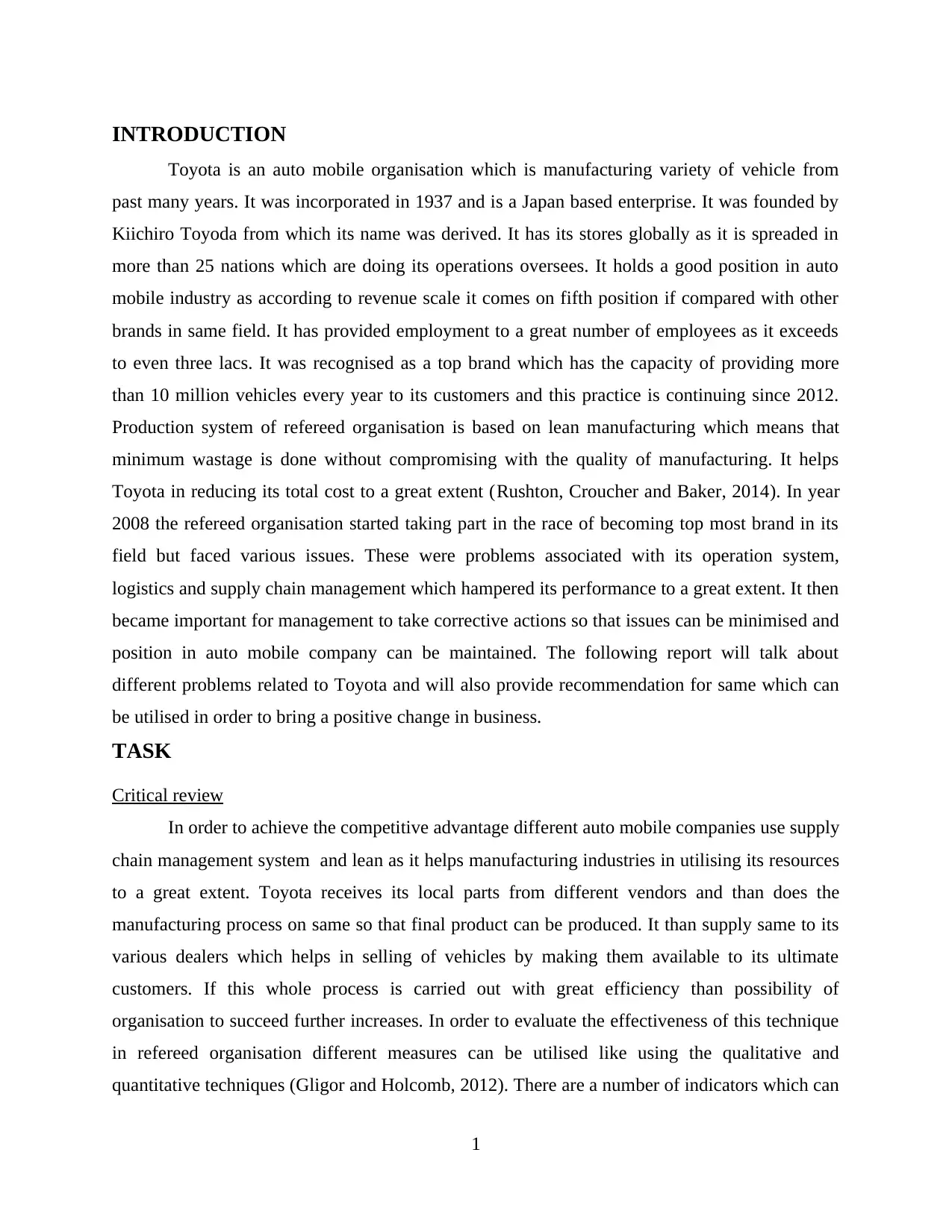
INTRODUCTION
Toyota is an auto mobile organisation which is manufacturing variety of vehicle from
past many years. It was incorporated in 1937 and is a Japan based enterprise. It was founded by
Kiichiro Toyoda from which its name was derived. It has its stores globally as it is spreaded in
more than 25 nations which are doing its operations oversees. It holds a good position in auto
mobile industry as according to revenue scale it comes on fifth position if compared with other
brands in same field. It has provided employment to a great number of employees as it exceeds
to even three lacs. It was recognised as a top brand which has the capacity of providing more
than 10 million vehicles every year to its customers and this practice is continuing since 2012.
Production system of refereed organisation is based on lean manufacturing which means that
minimum wastage is done without compromising with the quality of manufacturing. It helps
Toyota in reducing its total cost to a great extent (Rushton, Croucher and Baker, 2014). In year
2008 the refereed organisation started taking part in the race of becoming top most brand in its
field but faced various issues. These were problems associated with its operation system,
logistics and supply chain management which hampered its performance to a great extent. It then
became important for management to take corrective actions so that issues can be minimised and
position in auto mobile company can be maintained. The following report will talk about
different problems related to Toyota and will also provide recommendation for same which can
be utilised in order to bring a positive change in business.
TASK
Critical review
In order to achieve the competitive advantage different auto mobile companies use supply
chain management system and lean as it helps manufacturing industries in utilising its resources
to a great extent. Toyota receives its local parts from different vendors and than does the
manufacturing process on same so that final product can be produced. It than supply same to its
various dealers which helps in selling of vehicles by making them available to its ultimate
customers. If this whole process is carried out with great efficiency than possibility of
organisation to succeed further increases. In order to evaluate the effectiveness of this technique
in refereed organisation different measures can be utilised like using the qualitative and
quantitative techniques (Gligor and Holcomb, 2012). There are a number of indicators which can
1
Toyota is an auto mobile organisation which is manufacturing variety of vehicle from
past many years. It was incorporated in 1937 and is a Japan based enterprise. It was founded by
Kiichiro Toyoda from which its name was derived. It has its stores globally as it is spreaded in
more than 25 nations which are doing its operations oversees. It holds a good position in auto
mobile industry as according to revenue scale it comes on fifth position if compared with other
brands in same field. It has provided employment to a great number of employees as it exceeds
to even three lacs. It was recognised as a top brand which has the capacity of providing more
than 10 million vehicles every year to its customers and this practice is continuing since 2012.
Production system of refereed organisation is based on lean manufacturing which means that
minimum wastage is done without compromising with the quality of manufacturing. It helps
Toyota in reducing its total cost to a great extent (Rushton, Croucher and Baker, 2014). In year
2008 the refereed organisation started taking part in the race of becoming top most brand in its
field but faced various issues. These were problems associated with its operation system,
logistics and supply chain management which hampered its performance to a great extent. It then
became important for management to take corrective actions so that issues can be minimised and
position in auto mobile company can be maintained. The following report will talk about
different problems related to Toyota and will also provide recommendation for same which can
be utilised in order to bring a positive change in business.
TASK
Critical review
In order to achieve the competitive advantage different auto mobile companies use supply
chain management system and lean as it helps manufacturing industries in utilising its resources
to a great extent. Toyota receives its local parts from different vendors and than does the
manufacturing process on same so that final product can be produced. It than supply same to its
various dealers which helps in selling of vehicles by making them available to its ultimate
customers. If this whole process is carried out with great efficiency than possibility of
organisation to succeed further increases. In order to evaluate the effectiveness of this technique
in refereed organisation different measures can be utilised like using the qualitative and
quantitative techniques (Gligor and Holcomb, 2012). There are a number of indicators which can
1
⊘ This is a preview!⊘
Do you want full access?
Subscribe today to unlock all pages.

Trusted by 1+ million students worldwide
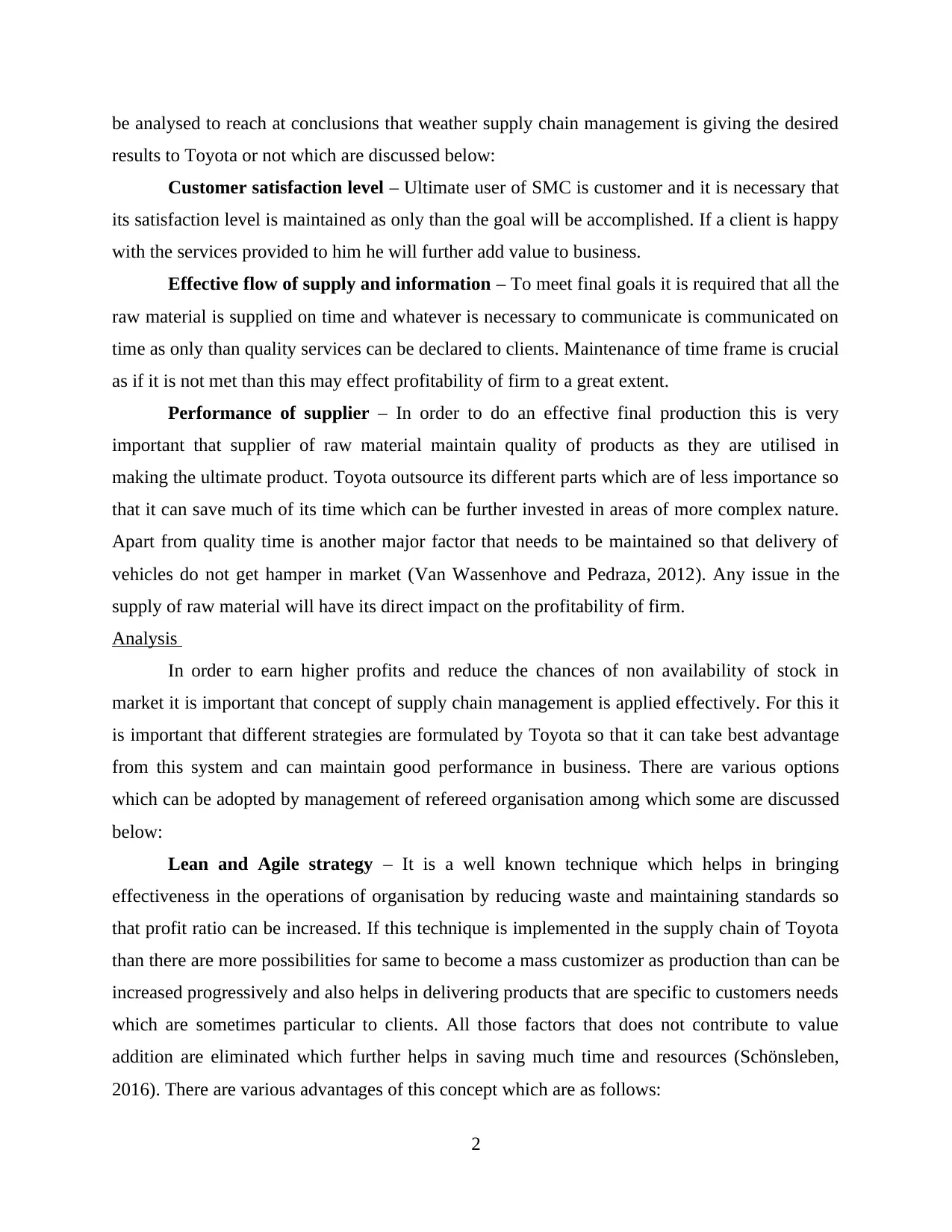
be analysed to reach at conclusions that weather supply chain management is giving the desired
results to Toyota or not which are discussed below:
Customer satisfaction level – Ultimate user of SMC is customer and it is necessary that
its satisfaction level is maintained as only than the goal will be accomplished. If a client is happy
with the services provided to him he will further add value to business.
Effective flow of supply and information – To meet final goals it is required that all the
raw material is supplied on time and whatever is necessary to communicate is communicated on
time as only than quality services can be declared to clients. Maintenance of time frame is crucial
as if it is not met than this may effect profitability of firm to a great extent.
Performance of supplier – In order to do an effective final production this is very
important that supplier of raw material maintain quality of products as they are utilised in
making the ultimate product. Toyota outsource its different parts which are of less importance so
that it can save much of its time which can be further invested in areas of more complex nature.
Apart from quality time is another major factor that needs to be maintained so that delivery of
vehicles do not get hamper in market (Van Wassenhove and Pedraza, 2012). Any issue in the
supply of raw material will have its direct impact on the profitability of firm.
Analysis
In order to earn higher profits and reduce the chances of non availability of stock in
market it is important that concept of supply chain management is applied effectively. For this it
is important that different strategies are formulated by Toyota so that it can take best advantage
from this system and can maintain good performance in business. There are various options
which can be adopted by management of refereed organisation among which some are discussed
below:
Lean and Agile strategy – It is a well known technique which helps in bringing
effectiveness in the operations of organisation by reducing waste and maintaining standards so
that profit ratio can be increased. If this technique is implemented in the supply chain of Toyota
than there are more possibilities for same to become a mass customizer as production than can be
increased progressively and also helps in delivering products that are specific to customers needs
which are sometimes particular to clients. All those factors that does not contribute to value
addition are eliminated which further helps in saving much time and resources (Schönsleben,
2016). There are various advantages of this concept which are as follows:
2
results to Toyota or not which are discussed below:
Customer satisfaction level – Ultimate user of SMC is customer and it is necessary that
its satisfaction level is maintained as only than the goal will be accomplished. If a client is happy
with the services provided to him he will further add value to business.
Effective flow of supply and information – To meet final goals it is required that all the
raw material is supplied on time and whatever is necessary to communicate is communicated on
time as only than quality services can be declared to clients. Maintenance of time frame is crucial
as if it is not met than this may effect profitability of firm to a great extent.
Performance of supplier – In order to do an effective final production this is very
important that supplier of raw material maintain quality of products as they are utilised in
making the ultimate product. Toyota outsource its different parts which are of less importance so
that it can save much of its time which can be further invested in areas of more complex nature.
Apart from quality time is another major factor that needs to be maintained so that delivery of
vehicles do not get hamper in market (Van Wassenhove and Pedraza, 2012). Any issue in the
supply of raw material will have its direct impact on the profitability of firm.
Analysis
In order to earn higher profits and reduce the chances of non availability of stock in
market it is important that concept of supply chain management is applied effectively. For this it
is important that different strategies are formulated by Toyota so that it can take best advantage
from this system and can maintain good performance in business. There are various options
which can be adopted by management of refereed organisation among which some are discussed
below:
Lean and Agile strategy – It is a well known technique which helps in bringing
effectiveness in the operations of organisation by reducing waste and maintaining standards so
that profit ratio can be increased. If this technique is implemented in the supply chain of Toyota
than there are more possibilities for same to become a mass customizer as production than can be
increased progressively and also helps in delivering products that are specific to customers needs
which are sometimes particular to clients. All those factors that does not contribute to value
addition are eliminated which further helps in saving much time and resources (Schönsleben,
2016). There are various advantages of this concept which are as follows:
2
Paraphrase This Document
Need a fresh take? Get an instant paraphrase of this document with our AI Paraphraser
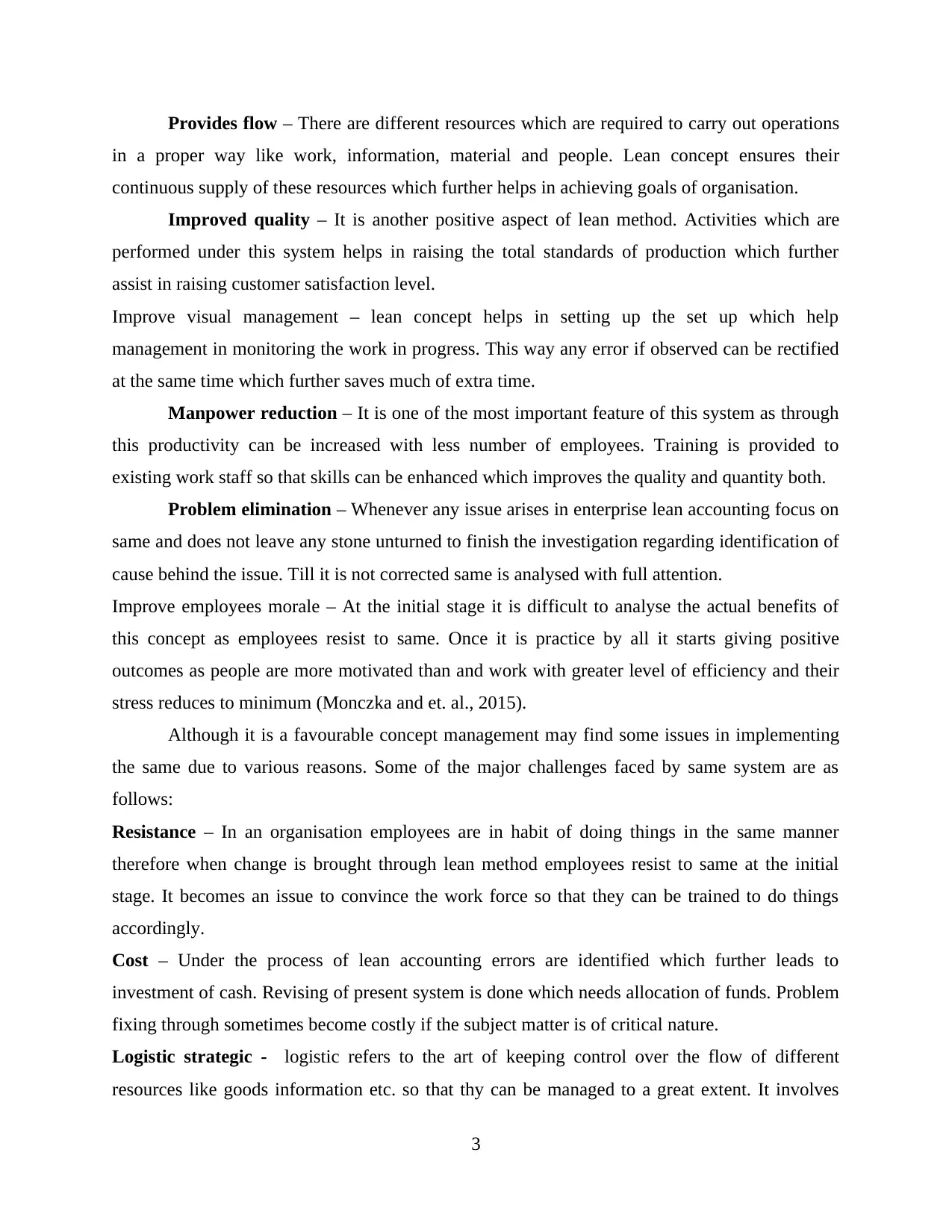
Provides flow – There are different resources which are required to carry out operations
in a proper way like work, information, material and people. Lean concept ensures their
continuous supply of these resources which further helps in achieving goals of organisation.
Improved quality – It is another positive aspect of lean method. Activities which are
performed under this system helps in raising the total standards of production which further
assist in raising customer satisfaction level.
Improve visual management – lean concept helps in setting up the set up which help
management in monitoring the work in progress. This way any error if observed can be rectified
at the same time which further saves much of extra time.
Manpower reduction – It is one of the most important feature of this system as through
this productivity can be increased with less number of employees. Training is provided to
existing work staff so that skills can be enhanced which improves the quality and quantity both.
Problem elimination – Whenever any issue arises in enterprise lean accounting focus on
same and does not leave any stone unturned to finish the investigation regarding identification of
cause behind the issue. Till it is not corrected same is analysed with full attention.
Improve employees morale – At the initial stage it is difficult to analyse the actual benefits of
this concept as employees resist to same. Once it is practice by all it starts giving positive
outcomes as people are more motivated than and work with greater level of efficiency and their
stress reduces to minimum (Monczka and et. al., 2015).
Although it is a favourable concept management may find some issues in implementing
the same due to various reasons. Some of the major challenges faced by same system are as
follows:
Resistance – In an organisation employees are in habit of doing things in the same manner
therefore when change is brought through lean method employees resist to same at the initial
stage. It becomes an issue to convince the work force so that they can be trained to do things
accordingly.
Cost – Under the process of lean accounting errors are identified which further leads to
investment of cash. Revising of present system is done which needs allocation of funds. Problem
fixing through sometimes become costly if the subject matter is of critical nature.
Logistic strategic - logistic refers to the art of keeping control over the flow of different
resources like goods information etc. so that thy can be managed to a great extent. It involves
3
in a proper way like work, information, material and people. Lean concept ensures their
continuous supply of these resources which further helps in achieving goals of organisation.
Improved quality – It is another positive aspect of lean method. Activities which are
performed under this system helps in raising the total standards of production which further
assist in raising customer satisfaction level.
Improve visual management – lean concept helps in setting up the set up which help
management in monitoring the work in progress. This way any error if observed can be rectified
at the same time which further saves much of extra time.
Manpower reduction – It is one of the most important feature of this system as through
this productivity can be increased with less number of employees. Training is provided to
existing work staff so that skills can be enhanced which improves the quality and quantity both.
Problem elimination – Whenever any issue arises in enterprise lean accounting focus on
same and does not leave any stone unturned to finish the investigation regarding identification of
cause behind the issue. Till it is not corrected same is analysed with full attention.
Improve employees morale – At the initial stage it is difficult to analyse the actual benefits of
this concept as employees resist to same. Once it is practice by all it starts giving positive
outcomes as people are more motivated than and work with greater level of efficiency and their
stress reduces to minimum (Monczka and et. al., 2015).
Although it is a favourable concept management may find some issues in implementing
the same due to various reasons. Some of the major challenges faced by same system are as
follows:
Resistance – In an organisation employees are in habit of doing things in the same manner
therefore when change is brought through lean method employees resist to same at the initial
stage. It becomes an issue to convince the work force so that they can be trained to do things
accordingly.
Cost – Under the process of lean accounting errors are identified which further leads to
investment of cash. Revising of present system is done which needs allocation of funds. Problem
fixing through sometimes become costly if the subject matter is of critical nature.
Logistic strategic - logistic refers to the art of keeping control over the flow of different
resources like goods information etc. so that thy can be managed to a great extent. It involves
3
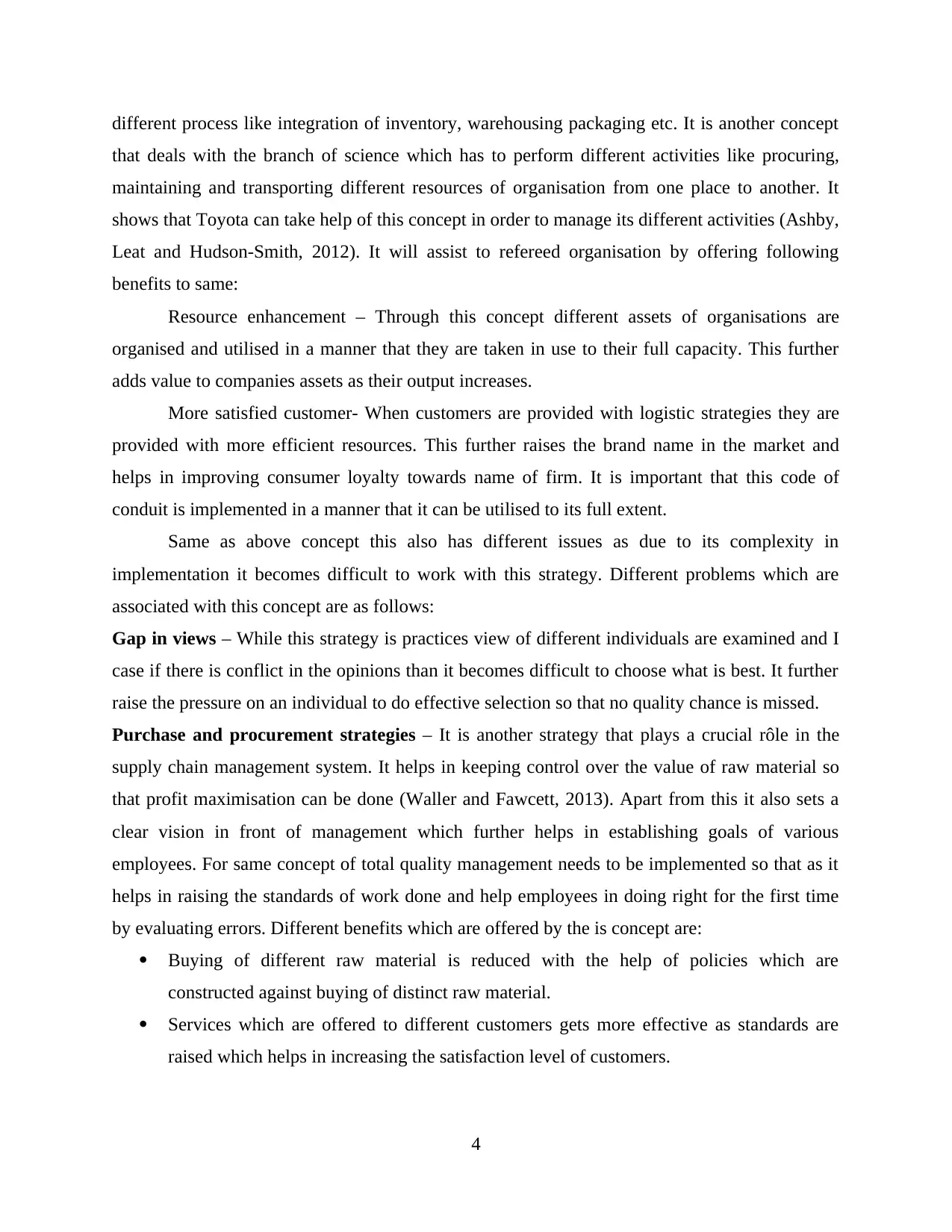
different process like integration of inventory, warehousing packaging etc. It is another concept
that deals with the branch of science which has to perform different activities like procuring,
maintaining and transporting different resources of organisation from one place to another. It
shows that Toyota can take help of this concept in order to manage its different activities (Ashby,
Leat and Hudson-Smith, 2012). It will assist to refereed organisation by offering following
benefits to same:
Resource enhancement – Through this concept different assets of organisations are
organised and utilised in a manner that they are taken in use to their full capacity. This further
adds value to companies assets as their output increases.
More satisfied customer- When customers are provided with logistic strategies they are
provided with more efficient resources. This further raises the brand name in the market and
helps in improving consumer loyalty towards name of firm. It is important that this code of
conduit is implemented in a manner that it can be utilised to its full extent.
Same as above concept this also has different issues as due to its complexity in
implementation it becomes difficult to work with this strategy. Different problems which are
associated with this concept are as follows:
Gap in views – While this strategy is practices view of different individuals are examined and I
case if there is conflict in the opinions than it becomes difficult to choose what is best. It further
raise the pressure on an individual to do effective selection so that no quality chance is missed.
Purchase and procurement strategies – It is another strategy that plays a crucial rôle in the
supply chain management system. It helps in keeping control over the value of raw material so
that profit maximisation can be done (Waller and Fawcett, 2013). Apart from this it also sets a
clear vision in front of management which further helps in establishing goals of various
employees. For same concept of total quality management needs to be implemented so that as it
helps in raising the standards of work done and help employees in doing right for the first time
by evaluating errors. Different benefits which are offered by the is concept are:
Buying of different raw material is reduced with the help of policies which are
constructed against buying of distinct raw material.
Services which are offered to different customers gets more effective as standards are
raised which helps in increasing the satisfaction level of customers.
4
that deals with the branch of science which has to perform different activities like procuring,
maintaining and transporting different resources of organisation from one place to another. It
shows that Toyota can take help of this concept in order to manage its different activities (Ashby,
Leat and Hudson-Smith, 2012). It will assist to refereed organisation by offering following
benefits to same:
Resource enhancement – Through this concept different assets of organisations are
organised and utilised in a manner that they are taken in use to their full capacity. This further
adds value to companies assets as their output increases.
More satisfied customer- When customers are provided with logistic strategies they are
provided with more efficient resources. This further raises the brand name in the market and
helps in improving consumer loyalty towards name of firm. It is important that this code of
conduit is implemented in a manner that it can be utilised to its full extent.
Same as above concept this also has different issues as due to its complexity in
implementation it becomes difficult to work with this strategy. Different problems which are
associated with this concept are as follows:
Gap in views – While this strategy is practices view of different individuals are examined and I
case if there is conflict in the opinions than it becomes difficult to choose what is best. It further
raise the pressure on an individual to do effective selection so that no quality chance is missed.
Purchase and procurement strategies – It is another strategy that plays a crucial rôle in the
supply chain management system. It helps in keeping control over the value of raw material so
that profit maximisation can be done (Waller and Fawcett, 2013). Apart from this it also sets a
clear vision in front of management which further helps in establishing goals of various
employees. For same concept of total quality management needs to be implemented so that as it
helps in raising the standards of work done and help employees in doing right for the first time
by evaluating errors. Different benefits which are offered by the is concept are:
Buying of different raw material is reduced with the help of policies which are
constructed against buying of distinct raw material.
Services which are offered to different customers gets more effective as standards are
raised which helps in increasing the satisfaction level of customers.
4
⊘ This is a preview!⊘
Do you want full access?
Subscribe today to unlock all pages.

Trusted by 1+ million students worldwide
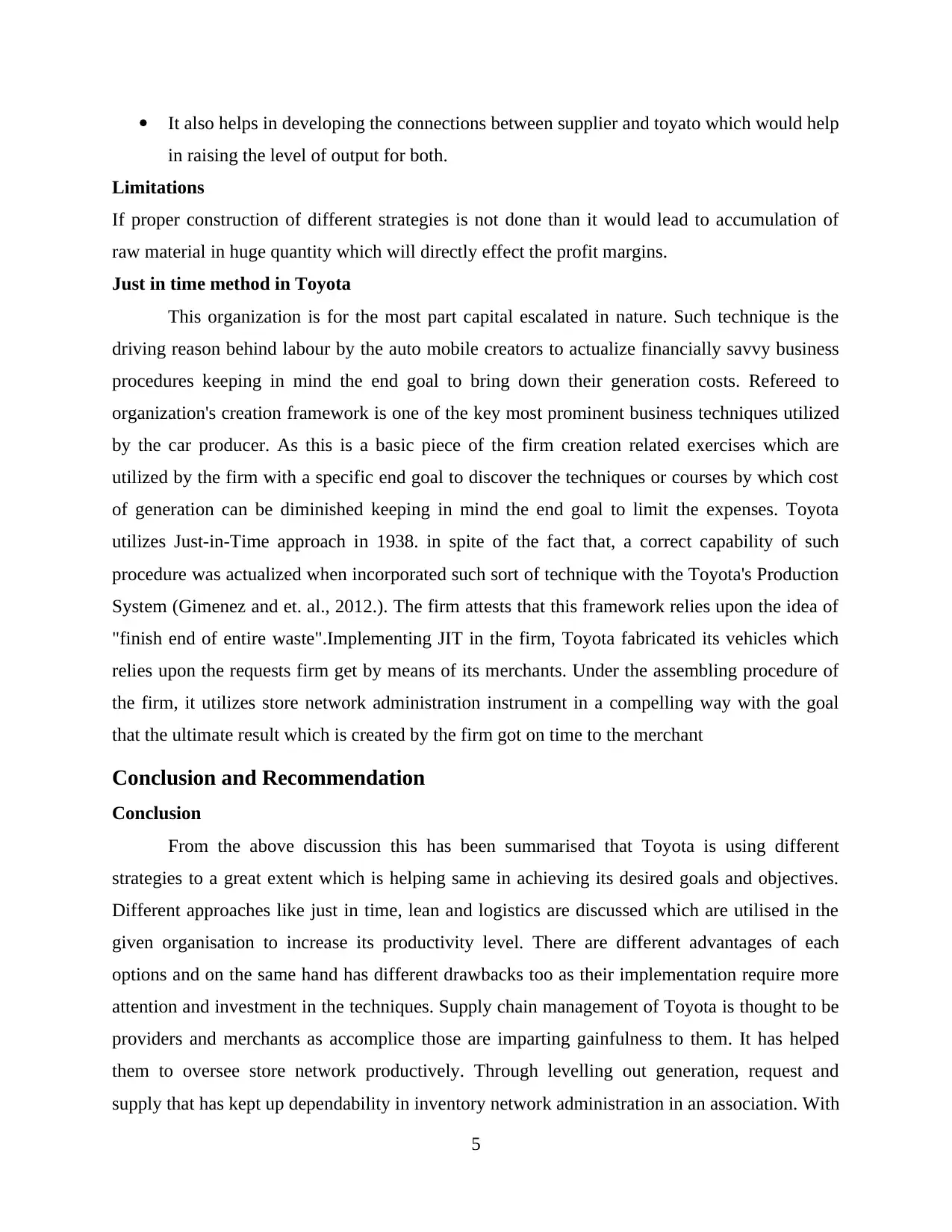
It also helps in developing the connections between supplier and toyato which would help
in raising the level of output for both.
Limitations
If proper construction of different strategies is not done than it would lead to accumulation of
raw material in huge quantity which will directly effect the profit margins.
Just in time method in Toyota
This organization is for the most part capital escalated in nature. Such technique is the
driving reason behind labour by the auto mobile creators to actualize financially savvy business
procedures keeping in mind the end goal to bring down their generation costs. Refereed to
organization's creation framework is one of the key most prominent business techniques utilized
by the car producer. As this is a basic piece of the firm creation related exercises which are
utilized by the firm with a specific end goal to discover the techniques or courses by which cost
of generation can be diminished keeping in mind the end goal to limit the expenses. Toyota
utilizes Just-in-Time approach in 1938. in spite of the fact that, a correct capability of such
procedure was actualized when incorporated such sort of technique with the Toyota's Production
System (Gimenez and et. al., 2012.). The firm attests that this framework relies upon the idea of
"finish end of entire waste".Implementing JIT in the firm, Toyota fabricated its vehicles which
relies upon the requests firm get by means of its merchants. Under the assembling procedure of
the firm, it utilizes store network administration instrument in a compelling way with the goal
that the ultimate result which is created by the firm got on time to the merchant
Conclusion and Recommendation
Conclusion
From the above discussion this has been summarised that Toyota is using different
strategies to a great extent which is helping same in achieving its desired goals and objectives.
Different approaches like just in time, lean and logistics are discussed which are utilised in the
given organisation to increase its productivity level. There are different advantages of each
options and on the same hand has different drawbacks too as their implementation require more
attention and investment in the techniques. Supply chain management of Toyota is thought to be
providers and merchants as accomplice those are imparting gainfulness to them. It has helped
them to oversee store network productively. Through levelling out generation, request and
supply that has kept up dependability in inventory network administration in an association. With
5
in raising the level of output for both.
Limitations
If proper construction of different strategies is not done than it would lead to accumulation of
raw material in huge quantity which will directly effect the profit margins.
Just in time method in Toyota
This organization is for the most part capital escalated in nature. Such technique is the
driving reason behind labour by the auto mobile creators to actualize financially savvy business
procedures keeping in mind the end goal to bring down their generation costs. Refereed to
organization's creation framework is one of the key most prominent business techniques utilized
by the car producer. As this is a basic piece of the firm creation related exercises which are
utilized by the firm with a specific end goal to discover the techniques or courses by which cost
of generation can be diminished keeping in mind the end goal to limit the expenses. Toyota
utilizes Just-in-Time approach in 1938. in spite of the fact that, a correct capability of such
procedure was actualized when incorporated such sort of technique with the Toyota's Production
System (Gimenez and et. al., 2012.). The firm attests that this framework relies upon the idea of
"finish end of entire waste".Implementing JIT in the firm, Toyota fabricated its vehicles which
relies upon the requests firm get by means of its merchants. Under the assembling procedure of
the firm, it utilizes store network administration instrument in a compelling way with the goal
that the ultimate result which is created by the firm got on time to the merchant
Conclusion and Recommendation
Conclusion
From the above discussion this has been summarised that Toyota is using different
strategies to a great extent which is helping same in achieving its desired goals and objectives.
Different approaches like just in time, lean and logistics are discussed which are utilised in the
given organisation to increase its productivity level. There are different advantages of each
options and on the same hand has different drawbacks too as their implementation require more
attention and investment in the techniques. Supply chain management of Toyota is thought to be
providers and merchants as accomplice those are imparting gainfulness to them. It has helped
them to oversee store network productively. Through levelling out generation, request and
supply that has kept up dependability in inventory network administration in an association. With
5
Paraphrase This Document
Need a fresh take? Get an instant paraphrase of this document with our AI Paraphraser
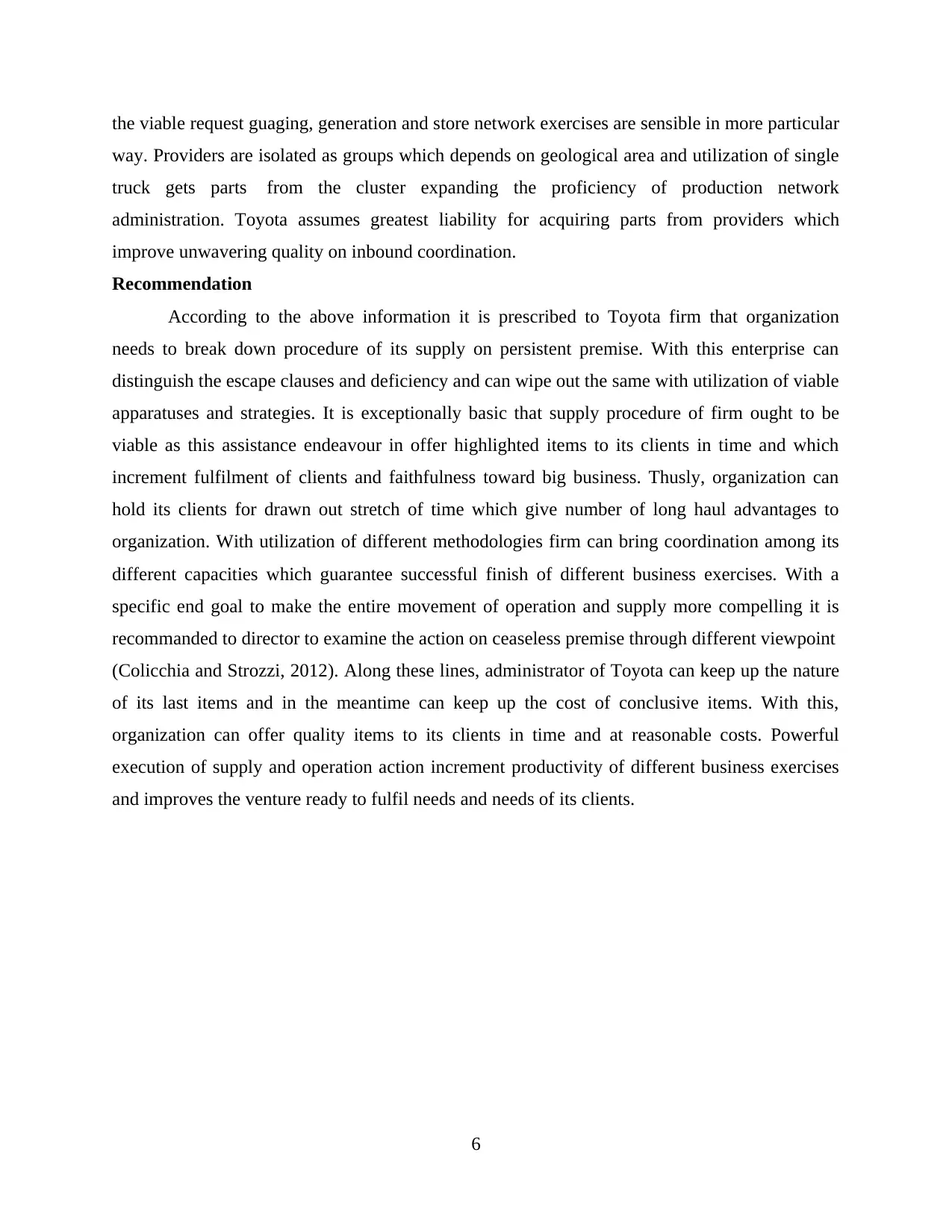
the viable request guaging, generation and store network exercises are sensible in more particular
way. Providers are isolated as groups which depends on geological area and utilization of single
truck gets parts from the cluster expanding the proficiency of production network
administration. Toyota assumes greatest liability for acquiring parts from providers which
improve unwavering quality on inbound coordination.
Recommendation
According to the above information it is prescribed to Toyota firm that organization
needs to break down procedure of its supply on persistent premise. With this enterprise can
distinguish the escape clauses and deficiency and can wipe out the same with utilization of viable
apparatuses and strategies. It is exceptionally basic that supply procedure of firm ought to be
viable as this assistance endeavour in offer highlighted items to its clients in time and which
increment fulfilment of clients and faithfulness toward big business. Thusly, organization can
hold its clients for drawn out stretch of time which give number of long haul advantages to
organization. With utilization of different methodologies firm can bring coordination among its
different capacities which guarantee successful finish of different business exercises. With a
specific end goal to make the entire movement of operation and supply more compelling it is
recommanded to director to examine the action on ceaseless premise through different viewpoint
(Colicchia and Strozzi, 2012). Along these lines, administrator of Toyota can keep up the nature
of its last items and in the meantime can keep up the cost of conclusive items. With this,
organization can offer quality items to its clients in time and at reasonable costs. Powerful
execution of supply and operation action increment productivity of different business exercises
and improves the venture ready to fulfil needs and needs of its clients.
6
way. Providers are isolated as groups which depends on geological area and utilization of single
truck gets parts from the cluster expanding the proficiency of production network
administration. Toyota assumes greatest liability for acquiring parts from providers which
improve unwavering quality on inbound coordination.
Recommendation
According to the above information it is prescribed to Toyota firm that organization
needs to break down procedure of its supply on persistent premise. With this enterprise can
distinguish the escape clauses and deficiency and can wipe out the same with utilization of viable
apparatuses and strategies. It is exceptionally basic that supply procedure of firm ought to be
viable as this assistance endeavour in offer highlighted items to its clients in time and which
increment fulfilment of clients and faithfulness toward big business. Thusly, organization can
hold its clients for drawn out stretch of time which give number of long haul advantages to
organization. With utilization of different methodologies firm can bring coordination among its
different capacities which guarantee successful finish of different business exercises. With a
specific end goal to make the entire movement of operation and supply more compelling it is
recommanded to director to examine the action on ceaseless premise through different viewpoint
(Colicchia and Strozzi, 2012). Along these lines, administrator of Toyota can keep up the nature
of its last items and in the meantime can keep up the cost of conclusive items. With this,
organization can offer quality items to its clients in time and at reasonable costs. Powerful
execution of supply and operation action increment productivity of different business exercises
and improves the venture ready to fulfil needs and needs of its clients.
6
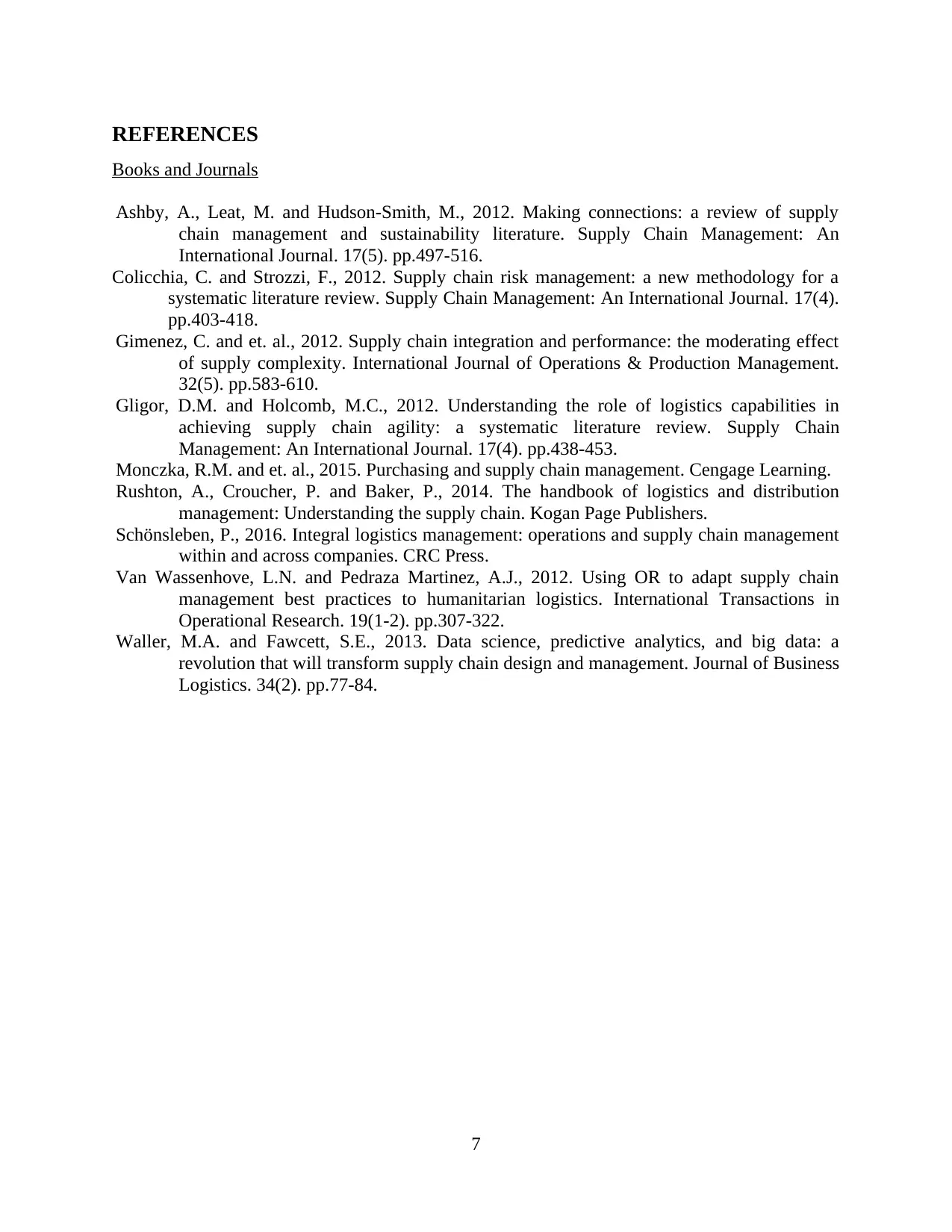
REFERENCES
Books and Journals
Ashby, A., Leat, M. and Hudson-Smith, M., 2012. Making connections: a review of supply
chain management and sustainability literature. Supply Chain Management: An
International Journal. 17(5). pp.497-516.
Colicchia, C. and Strozzi, F., 2012. Supply chain risk management: a new methodology for a
systematic literature review. Supply Chain Management: An International Journal. 17(4).
pp.403-418.
Gimenez, C. and et. al., 2012. Supply chain integration and performance: the moderating effect
of supply complexity. International Journal of Operations & Production Management.
32(5). pp.583-610.
Gligor, D.M. and Holcomb, M.C., 2012. Understanding the role of logistics capabilities in
achieving supply chain agility: a systematic literature review. Supply Chain
Management: An International Journal. 17(4). pp.438-453.
Monczka, R.M. and et. al., 2015. Purchasing and supply chain management. Cengage Learning.
Rushton, A., Croucher, P. and Baker, P., 2014. The handbook of logistics and distribution
management: Understanding the supply chain. Kogan Page Publishers.
Schönsleben, P., 2016. Integral logistics management: operations and supply chain management
within and across companies. CRC Press.
Van Wassenhove, L.N. and Pedraza Martinez, A.J., 2012. Using OR to adapt supply chain
management best practices to humanitarian logistics. International Transactions in
Operational Research. 19(1-2). pp.307-322.
Waller, M.A. and Fawcett, S.E., 2013. Data science, predictive analytics, and big data: a
revolution that will transform supply chain design and management. Journal of Business
Logistics. 34(2). pp.77-84.
7
Books and Journals
Ashby, A., Leat, M. and Hudson-Smith, M., 2012. Making connections: a review of supply
chain management and sustainability literature. Supply Chain Management: An
International Journal. 17(5). pp.497-516.
Colicchia, C. and Strozzi, F., 2012. Supply chain risk management: a new methodology for a
systematic literature review. Supply Chain Management: An International Journal. 17(4).
pp.403-418.
Gimenez, C. and et. al., 2012. Supply chain integration and performance: the moderating effect
of supply complexity. International Journal of Operations & Production Management.
32(5). pp.583-610.
Gligor, D.M. and Holcomb, M.C., 2012. Understanding the role of logistics capabilities in
achieving supply chain agility: a systematic literature review. Supply Chain
Management: An International Journal. 17(4). pp.438-453.
Monczka, R.M. and et. al., 2015. Purchasing and supply chain management. Cengage Learning.
Rushton, A., Croucher, P. and Baker, P., 2014. The handbook of logistics and distribution
management: Understanding the supply chain. Kogan Page Publishers.
Schönsleben, P., 2016. Integral logistics management: operations and supply chain management
within and across companies. CRC Press.
Van Wassenhove, L.N. and Pedraza Martinez, A.J., 2012. Using OR to adapt supply chain
management best practices to humanitarian logistics. International Transactions in
Operational Research. 19(1-2). pp.307-322.
Waller, M.A. and Fawcett, S.E., 2013. Data science, predictive analytics, and big data: a
revolution that will transform supply chain design and management. Journal of Business
Logistics. 34(2). pp.77-84.
7
⊘ This is a preview!⊘
Do you want full access?
Subscribe today to unlock all pages.

Trusted by 1+ million students worldwide

8
1 out of 10
Related Documents
Your All-in-One AI-Powered Toolkit for Academic Success.
+13062052269
info@desklib.com
Available 24*7 on WhatsApp / Email
![[object Object]](/_next/static/media/star-bottom.7253800d.svg)
Unlock your academic potential
Copyright © 2020–2025 A2Z Services. All Rights Reserved. Developed and managed by ZUCOL.





